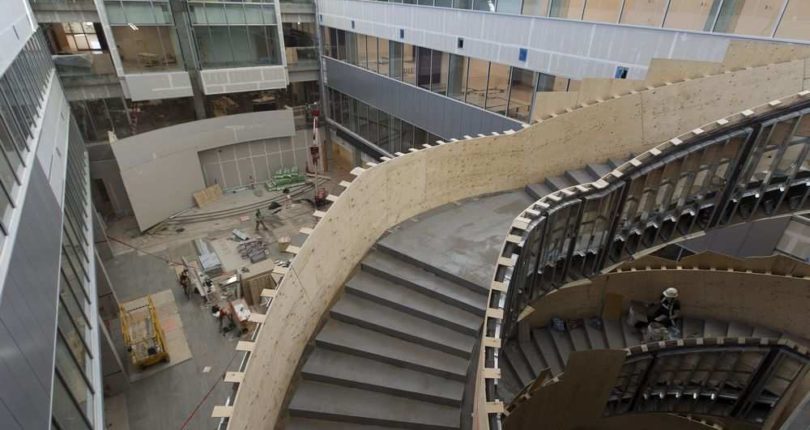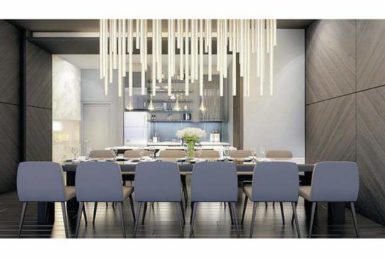Forgotten child no more: NorQuest College makes its dreams come true

Paula Simons: Forgotten child no more: NorQuest College makes its dreams come true
It’s only June. But inside the Singhmar Centre for Learning, the back-to-school excitement is feverish. PCL construction workers are beavering away, putting the finishing touches on the striking addition to the NorQuest College campus — the first new building NorQuest has seen in 47 years.
Think how the University of Alberta, NAIT and MacEwan University have changed since 1970. Think of all the new buildings they’ve built, how their campuses have grown.

Meanwhile, NorQuest has been making do with one eight-storey Brutalist office block on 108 Street at 102 Avenue. As the college has grown, it’s leased spaces scattered through central Edmonton. But given it now serves some 16,000 students a year, and given attendance is booming — up 17 per cent in the last year — new space is long overdue.
That’s why NorQuest president Jodi Abbott is beaming as she survey’s NorQuest’s new four-storey, $112-million building — 22,500 square metres of classrooms, labs, libraries and meeting spaces, awash in natural daylight. It faces 108 Street and is flanked by 103 Avenue and 107 Street.
“We’ve been a bit of the forgotten child,” says Abbott. “We’ve been waiting for this for 12 years.”
Classes will begin in the new building Sept. 5.
This will be a very different space than what NorQuest students have known before. It will make the school feel less like an oversized high school and much more like a true college experience.

The main floor features a dramatic sunny atrium with an elegant “floating” staircase. There will be restaurants — a Pizza 73, a Tim Hortons and a Subway — that open out onto an outdoor patio. There will be a large daycare, which will also function as a hands-on lab/classroom/practicum space for NorQuest’s early learning and child care programs.
The huge library, which wraps around the second floor, will be 70 per cent larger than the old one and feature not just course materials and computers, but a collection of children’s books so that English-as-a-second-language students can learn together with their children.
There will be a bright and welcoming indigenous student centre, specially ventilated for smudging ceremonies, featuring dramatic art work by Kainai/Blood artistKalum Teke Dan.
And it will all be connected to the older tower by multiple pedways.
“There will be so many spaces for socialization and collaboration, for teamwork,” said Steve Yacucha, project manager for the Singhmar build.
That’s something the old building just doesn’t provide, he says. And, he adds proudly, the project is on time and slightly under budget.
It’s a welcome change. The college is the Rodney Dangerfield of Edmonton’s post-secondary sector. It trains everyone from licensed practical nurses to fire inspectors to accounting technicians. And it provides English-as-a-second-language classes and high school upgrading for people who need support to prepare to enter the workforce.

Almost 60 per cent of its students were born outside of Canada and there are more than 100 languages spoken on campus. It not only gives students the skills to fill essential jobs. It gives its very diverse students a real opportunity to integrate into the workforce — and into the larger community.
Yet funding remains a challenge. The Singhmar Centre is part of a larger $194-million campus reboot, which includes a retrofit of the existing tower. Of that, $170 million came from the province, with $1.2 million from Ottawa. But efforts to raise another $20 million in a capital campaign have stalled with $14.7 million collected so far.
There was a generous $2.5-million gift from Edmonton doctors and entrepreneurs Prem and Saroj Singhmar, who’ve given their name to the centre. Community donors raised another $1 million for the daycare. Abbott says they’ll announce another $2 million from a private donor soon. The Edmonton Oilers Community Foundation donated $1.5 million. But Abbott said donations from major corporations have been few.

“It is getting tougher and tougher,” she said. “We need corporations to step up. It frustrating, because our entire focus is workforce readiness.”
Part of the problem may be that NorQuest, in its concrete bunker, hasn’t felt truly connected to the community. The Singhmar Centre will be a much more open, public building, more engaged with the urban streetscape around it. Meanwhile, a new city bike lane right past the college is about to open, a new sculpture garden along 108 Street — a.k.a. Capital Boulevard — will be installed this summer, and the future west LRT is planned to stop right at the campus. All that municipal infrastructure will connect NorQuest with the larger downtown in a whole new way.
It won’t come too soon. NorQuest can be a key part of Edmonton’s downtown renewal. And Edmonton’s downtown renewal can be a key part of redefining NorQuest’s identity.



Join The Discussion